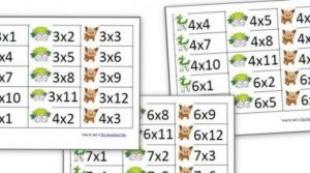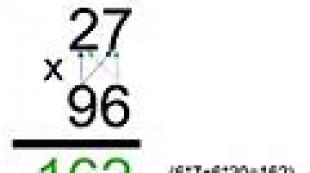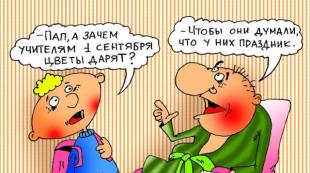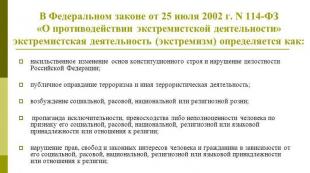How to multiply two-digit to two-digit in mind. Mystery magic mathematics. How to learn how to quickly read in the mind. How to multiply two-digit numbers in mind
The usual school mathematics can be very practical in everyday life, because it makes it possible to conduct serious arithmetic calculations in the mind. We will tell you several techniques that help multiply double-digit numbers quickly without using a calculator or sheet of paper and handles.
How to multiply two-digit numbers in the mind?
It may seem that multiplied in the mind such large numbers is impossible, but it is not. There is a way that will be understood even to schoolchildren.
For example, take numbers 96 and 97.
Calculate the difference between these numbers relative to 100. In our case, it is 3 and 4. Their work will be the second part of the multiplication solution of numbers 97 and 96 (3 * 4 \u003d 12).
The first part will be the difference of the first number and the difference of 100 and the second number. In our example, it is: 97-4 \u003d 93.
Thus, we get 97 * 96 \u003d 93 12
How to quickly multiply in the mind?
The essence of this simple and usual way is to decompose multipliers per units and dozens. Then follow their alternate multiplication. Make it just, in the mind you will have to keep no more than 3 numbers at the same time.
Here is a standard method of such multiplication:
64*86 = (60+4)*(80+6) = 60*80 + 60*6 + 4*80 + 4*6 = 4800 + 360 + 320 + 24 = 5504
But the method calculated by only 3 actions.
1
) Multiply dozens of 60 and 80. Result 4800, remember it.
2
) Fold the works 60 * 6 and 80 * 4. It turns out 680. Remember this number.
3
) Multiply units 4 * 6 \u003d 24 and fold all three numbers. 4800 + 680 +24 \u003d 5504.
See how easy you can multiply in your mind!
Some quick methods oral multiplication We have already disassembled, now let's figure it out more about how to quickly multiply the numbers in the mind, using various auxiliary methods. You may already know, and some of them are rather exotic, for example, an ancient Chinese way of multiplication of numbers.
Laying on discharges
 It is the simplest reception of the quick multiplication of two-digit numbers. Both multipliers need to be divided into dozens and units, and then all these new numbers multiply each other.
It is the simplest reception of the quick multiplication of two-digit numbers. Both multipliers need to be divided into dozens and units, and then all these new numbers multiply each other.
This method requires the ability to hold in memory at the same time up to four numbers, and do with these number of calculations.
For example, you need to multiply numbers 38 and 56 . We do this as follows:
38 * 56 = (30 + 8) * (50 + 6) = 30 * 50 + 8 * 50 + 30 * 6 + 8 * 6 = 1500 + 400 + 180 + 48 = 2128 It is even easier to make the oral multiplication of two-digit numbers in three actions. First you need to multiply dozens, then add two pieces of units per dozens, and then add the piece of units per unit. It looks like this: 38 * 56 = (30 + 8) * (50 + 6) = 30 * 50 + (8 * 50 + 30 * 6) + 8 * 6 = 1500 + 580 + 48 = 2128 In order to successfully use this way, you need to know the multiplication table well, be able to quickly fold two-digit and three-digit numbers, and switch between mathematical actions, not forgetting intermediate results. The last skill is achieved by and visualization.
This method is not the fastest and efficient, therefore it is worth studying other ways of oral multiplication.
Fit numbers
You can try to bring an arithmetic calculation to a more convenient mind. For example, the product of numbers 35
and 49
You can imagine in this way: 35 * 49 = (35 * 100) / 2 — 35 = 1715
This method may be more efficient than the previous one, but it is not universal, and is not suitable for all cases. You can not always find a suitable algorithm to simplify the task.
This topic was remembered by the anecdote about how the mathematician sailed on the river past the farm, and stated to the interlocutors that he managed to quickly calculate the amount of sheep in the pen, 1358 sheep. When he was asked how he succeeded, he said that everything was simple - you need to calculate the number of legs, and divided by 4.
Visualization of multiplication in the column
This one of the most universal methods of oral multiplication of numbers, developing spatial imagination and memory. To begin with, learn to multiply in the column in the mind two-digit numbers on unambiguous. After that, you can easily multiply two-digit numbers in three actions. At first, the two-digit number must be multiplied by dozens of other numbers, then multiply by other numbers, and then sum up the numbers obtained.
It looks like this: 38 * 56 = (38 * 5) * 10 + 38 * 6 = 1900 + 228 = 2128
Visualization with arrangements
A very interesting method for multiplying two-digit numbers is next. You need to multiply the numbers in numbers to multiply so that hundreds, units and tens.
Suppose you need to multiply 35 on the 49 .
First, prolonge 3 on the 4 , Get 12 , then 5 and 9 , Get 45 . Record 12 and 5 , with a space between them, and 4 remember.
Get: 12 __ 5 (remember 4 ).
Now multiply 3 on the 9 , I. 5 on the 4 , and summarize: 3 * 9 + 5 * 4 = 27 + 20 = 47 .
Now you need K. 47 add 4 we remember. Receive 51 .
We write 1 in the middle and 5 add K. 12 Receive 17 .
TOTAL, the number we were looking for 1715 , it is the answer:
35 * 49 = 1715
Try to multiply in the same way: 18 * 34, 45 * 91, 31 * 52
.
Chinese, or Japanese, multiplication
In Asian countries, it is customary to multiply the numbers not in the column, but drawing lines. For Eastern cultures, the desire for contemplation, and visualization, therefore, probably, they came up with such a beautiful method, allowing multiplying any numbers. This method is complicated only at first glance. In fact, great visuality allows you to use this method much more efficiently than multiplication in the column.
In addition, the knowledge of this ancient Eastern ETOD increases your erudition. Agree, not everyone boasts what knows the ancient multiplication system, which the Chinese have used another 3000 years ago.
Video about how the Chinese are prolonged numbers
You can get more detailed information in the "All Courses" and "utility" sections in which you can go through the top menu of the site. In these sections, the article grouped on topics in blocks containing the most deployed (as far as possible) information on various topics.
You can also subscribe to a blog, and learn about all new articles.
It does not take much time. Just click the link below:
Multiplication of double-digit numbers - skill, extremely necessary for our daily life. People constantly face the need to multiply anything in mind: price tag in the store, a lot of products, or a discount size. But how to multiply two-digit numbers quickly and without problems? Let's figure it out.
How to multiply a two-digit number on unambiguous?
Let's start with a simple task - how to multiply two-digit numbers to unambiguous.
For a start, a two-digit number is a number that consists of a certain number of tens and units.
In order to multiply a two-digit number on an unambiguous in the column, you need to write the desired two-digit number, and the corresponding one-valued. Next, it should be multiplying to a specified number first, and then dozens. If the multiplication of units turned out to be more than 10, then the number of dozens need to be simply transferred to the next discharge by adding them.

Multiplication of double digits for tens
Multiplying two-digit numbers per dozens - the task is not much more complicated than multiplying to unambiguous numbers. The main procedure remains the same:
- To write down the numbers in each other into the column, while the zero should be as it were for the "side" in order not to interfere with arithmetic action.
- Multiply a two-digit number on the number of dozens, do not forget about the transfer of some numbers to the following discharges.
- The only thing that distinguishes this example from the previous one - at the end of the resulting answer you need to add zero, so dozens that have been omitted at the beginning become accounted for.

How to multiply two double numbers?
After you completely figured out the multiplication of double-digit and unambiguous numbers, you can begin to think how to multiply the two-digit numbers on each other. In fact, this action should also not require much effort from you, since the principle still remains the same.
- We write these numbers in the column - units under units, dozens are under dozens.
- We begin multiplication from the unit in the same way as in the examples with unambiguous numbers.
- After you received the first number, multiplying the units on this number, you need to multiply dozens on the same figure in the same way. Attention: the answer must be recorded strictly under dozens. The empty place under units is unaccounted zero. You can write it if you are so more convenient.
- Alternating and dozens, and units and receiving two numbers recorded one under one, they need to be folded into the column. The resulting value is the answer.
How to multiply two-digit numbers? It is not enough to just read or learn the instructions. Remember, in order to master the principle, how to multiply two-digit numbers, first of all you need to constantly practic - to solve as many examples as possible, as you can easily use the calculator.

How to multiply in mind
Having learned brilliantly multiplied on paper, you can wonder how to quickly multiply two-digit numbers in the mind.
Of course, this is not the easiest task. It requires some concentration, good memory, as well as the ability to keep a certain amount of information in the head. However, this can be learned, putting enough effort, especially if you choose the correct algorithm. Obviously, it is easiest to multiply on round numbers, so the easiest way is the decomposition of numbers for multipliers.
- To begin with, one of these two-digit numbers should be divided into dozens. For example, 48 \u003d 4 × 10 + 8.
- Next, you need to multiply the units first, and then dozens with the second number. These are quite complex for performing operations in the mind, as you need to multiply the numbers at each other at the same time and keep the result in the mind. Most likely, it will be difficult for you to cope with this task from the first time, but if you can be quite diligent, this skill can be developed, because it can be understood how to multiply two-digit numbers in the mind correctly in practice.
Some tricks when multiplying double digits
But is there an easier way to multiply two-digit numbers in your mind, and how to do it?
There are several tricks. They will help you easily and quickly multiply double-digit numbers.
- When multiplying, eleven you need to simply put the amount of tens and units in the middle of this two-digit number. For example, we needed to multiply 34 to 11.
We put 7 in the middle, 374. This is the answer.
If the number is obtained by more than 10, then you should simply add a unit to the first number. For example, 79 × 11.
- Sometimes it is easier to decompose the number of multipliers and consistently multiply them. For example, 16 \u003d 2 × 2 × 2 × 2, so you can simply multiply the initial number 4 times.
14 \u003d 2 × 7, so when performing mathematical operations, you can multiply first by 7, and then 2.
- In order to multiply the number in numbers, multiple 100, for example, 50 or 25, you can multiply this number 100, and then divided by 2 or 4, respectively.
- You still need to remember that sometimes you do not add to multiply, but take numbers from each other.
For example, in order to multiply the number 29, you can first multiply it by 30, and then take away the number from the resulting number once. This rule is valid for any dozens.
How to teach a child with multiplication quickly and easily, so that from the initial classes he solve different mathematical tasks well? If you want your child to receive comprehensive development, without help he can not do.
In our age abundance of information you can find many auxiliary materials - cards, courses in the game form, audio and video programs and much more, but none of the ways are universal. All children are unique in their own way, so the approach to everyone needs an individual. In our article, we offer you several ways to master the multiplication table. After examining them, you can choose the most effective for your child.
The study methods are now enough - only you need to choose the most suitable for the child.An important preparatory moment
When children begin to study the multiplication table, they already have an idea of \u200b\u200bsimpler arithmetic effects - addition and subtraction. Now you need to explain to them, what is the essence of the action of multiplication. Previously mastered skills will help you with this.
What is the principle of multiplication? This is multiple addition. For example, to multiply 4 by 3, you need to fold 3 times 4 (4 + 4 + 4). Having mastered this, the child will allow less errors in the future learning process.
In addition, children should understand how to navigate the table. It is necessary to explain that the product is the number at the intersection of the string and column.
Start
A large table with many numbers can lead a child in desire, if you do not completely repel the desire to learn. For this reason, it is better to start with the easiest examples. To cope with them, you do not need to make great efforts. In addition, the child will be able to fulfill them on their own, then part of the work will have already done:
- We multiply on 1. Any number remains the same number.
- What needs to be done to multiply by 10? Just only at the end of the number put 0.
- Multiplication by 2 is the addition of two identical numbers. At least, with ordinary numbers, children are already able to perform such actions when they start learning multiplication.
- The change of multipliers. This is the so-called moving (commutative) law of multiplication. That is, if there are multipliers in places, the work will not change. Thus, it turns out that you need to learn only half the table.
As you can see, the picture becomes more optimistic. The child will also notice and continue to work with great enthusiasm than at the beginning.

 The child must first understand that multiplication is a familiar addition to him, only multiple
The child must first understand that multiplication is a familiar addition to him, only multiple Targeted memorization
After mastering the most simple values, you can move on. To cope with more complex multipliers, you will need to connect other techniques - to repeat, crush part, build associations, apply knowledge in practice. Now it will take a multiple repetition of actions and values \u200b\u200bto memorize.
Opinions of teachers disagree in the question of a sequence of actions. Some adhere to the techniques, when the most complex examples are first mastered, and then simpler. Practice shows that such a method is not suitable for everyone and often can even cause a certain stress from students. The optimal option is considered to teach them first more simple actions and at the end - the most difficult. What is this explained? When multiplying small numbers (for example, 3 to 3), the child can test himself on the fingers - at the beginning of the training, this reception is useful. If you immediately oblige children to remember the work of 8 to 9, it will simply be a mechanical memorization without use in practice. This technique can easily demotivate.
Squares numbers
The new stage in the development of the multiplication table is starting from the squares of the numbers. To withdraw the square of the number - it means multiplying it to the most. Squares in the table are only 10, they are not so difficult to remember (in many ways it is due to the fact that some of them are stamped - for example, "five five to twenty five"). Square 10 to 10 remember nothing at all.
 So that the child really understands, and not only remembered the sign, start learning each row from a square
So that the child really understands, and not only remembered the sign, start learning each row from a square Multiplication by 3.
It is already a bit more complicated here. If you have noticed that the child is not given to memorizing any actions, analyze its inclinations and connect those auxiliary materials that are suitable in your case. For many children, cards are ideal. In the case of the humanitarian warehouse of the mind, it is good to use lessons in a poetic form (about the use of special poems to memorize, we will tell in detail in the section below).
Multiplication by 4.
Here will be a little simpler. Offer the child to try the most logically to build the action, and it will certainly guesses what to multiply by 4 is the same thing that you multiply 2 times on 2. If it is difficult, you can easily explain it to him. Cards and poems will also be useful at this stage of material development.
Multiply to 5 is also easy, children usually like this part of the educational process. First, all the values \u200b\u200bof this multiplication are located apart from 5 numbers. Secondly, they end on 5 or 0. At the end of even numbers multiplied by 5, it will stand 0, and odd - 5. As you can see, everything is simple.
 If we consider the works multiplied by 5 numbers, you can see - they all end 5 or 0
If we consider the works multiplied by 5 numbers, you can see - they all end 5 or 0 Multiplication by 6, 7, 8 and 9
The last stage in mastering the multiplication table is the most difficult, but it consists of memorizing only six works. To remember them well, you will have to work, because even many adults are confused with answers.
For the child to be easier, use cards, and not 6, and 12. With such a set of cards you can practice with a variety of places of multipliers, and this will greatly facilitate memorization.
Game with cards
Training in the form of a game for children is simply necessary. It performs the main function - contributes to the occurrence of interest. If the child is interested in the process, it will already be practically a guarantee that he successfully will win it.
Despite the fact that there are many more modern auxiliary devices and materials (programs, online games, sound posters and others), ordinary cards do not lose their popularity. They are accessible to everyone and easy to use. Even if you use different methods for learning multiplication table, cards will help you at any stage.
First of all, you need to print cards or cut and fill it manually. It is advisable to stick them to the cardboard for better safety during operation. On each card you need to write an example from the multiplication table. The answer is not needed.
What is the game itself? Since you will connect cards from anyone, even the earliest stage of learning, then each occupation needs to select those examples that correspond to today. Then the cards are mixed, and the child at random pulls any of the stack. He needs to read an example and call the correct answer. After that, the card is postponed to the side and the other is pulled out. If the child answered wrong, the card returns to the stack. At the same time, be sure to voicate the correct answer so that the child remember him and responds correctly when re-pulling this card.

 For advance learning kid enough to print a set of cards
For advance learning kid enough to print a set of cards The advantages of such a simple process:
- Summary memory connects. Children, especially visuals, it will be much easier to learn even the most difficult examples.
- Memory with this approach is much better given. Multiple repetition is carried out in dialogue form, not a simple shank.
- The result from the work done by the work sees immediately. He appears incentive to finish the game and exit the winner, without leaving a single card in a stack. In such a game approach, you can arrange a competition by connecting another child.
Other techniques study
The more receptions you will have in stock, the more successful the process of learning the multiplication table will be advanced. Different methods can be applied not only depending on the warehouse of the mind of children, but also from the level of complexity of a particular lesson. You just need to constantly analyze the situation and navigate it, then you can explain even the most difficult example, and your child is to quickly learn it. We bring to your attention some of these techniques. They are not harder than the game with cards.
Examples from practice
To find visual examples for learning, you do not need to go far - the many of them are near you in an ordinary everyday setting. Show observation and mince a little, then your child will be able to learn the multiplication table not only with ease, but with great interest.
How much should the wheels need for 3 machines? How much do you need to put colors for 3 beds, if each is placed on each? How much is the paws of 4 teddy bears? As you can see, the options are many. You can offer a child to independently find them or ask tasks to multiply to a friend, taking examples from the home environment.
 Excellent idea - teach a child with its own toys, household items, sweets and so on
Excellent idea - teach a child with its own toys, household items, sweets and so on Examples of increased complexity
More complex examples and those that the child is difficult to give, pay maximum attention. At the same time, do not overload children's memory - alternate simple and complex. When you see that the material is mastered, go to another. Do not try to lay out all the information to memorize immediately, divide it into several approaches.
Multiplication on the fingers
Using this technique, you can master the entire multiplication table, but the most popular in this case is multiplication by 6, 7, 8 and 9. It is possible to use it additionally on any lessons, but keep in mind that before showing such a game to the child, you need Itself well to figure out and learn its principle.
We put paper on the table, on top - hands with your fingers horizontally to each other. We supply the contours of the hands and numbers to the fingers in this way: big - 5, index - 6, medium - 7, Unnamed - 8, Mysinette - 9. These contours will be useful when we will shift your hands during the process. Now choose an example to decide: let it be multiplying 7 to 8. The middle finger of the left hand will denote 7, and the nameless right - 8. They need to be combined and move their hands to the edge of the table. Fingers in front of the connected, which will get down down, will indicate tens, and all other fingers that will stay on the table - units. Now we consider. At the bottom of the way 5 - therefore, dozens 5. The fingers that lie on the table, you need to multiply. On the left hand of 3, and on the right - 2. Now 3 multiply on 2 - we get 6 units. The answer is 56.
Now multiplication by 9. Put your hands next to the table so that your fingers are vertically. Each finger needs to be numbered from 1 to 10 from left to right. You can do it on paper not to get confused. The little finger of the left hand is 1, and the little finger is the right - 10. Now we will bend a finger with the number that we want to multiply by 9. For example, it will be 5. Fingers to the left of it will be tens, and on the right - units. Answer - 45.
Studying multiplication table with rhyme (poems)
This memorization refers to mnemotechnical. In receptions, abstract concepts are replaced by ideas based on any sensory perception (in this case - audio). That is, this technique is mostly psychological.
This method of memorizing information loves all children, regardless of the mind warehouse and character. Why? Rhyme is good and quickly remembered, poems picturesquely illustrate the content and teach short funny poems much more interesting than mechanically tooling let even simple examples.
However, it is not necessary to base the whole process at this reception, otherwise you risk overloading the child's memory excessive memorization. We would recommend to use it in the most difficult cases to remove the voltage and add the game element process. If you wish, you can even connect pictures illustrating any example in verses.
Find a poetic multiplication table is easy, there are several options for different authors. We give examples of tasks that usually cause difficulties in all. Some examples from Alexander Usacheva's book "Multiplication Table in verses":
- 6 x 9: We do not feel sorry for the bull. Roth open wider: six nine will be fifty-four.
- 7 x 8: Once deer asked Elk: - How much will the family be eight? - elk did not become
In the textbook to climb: - Fifty, of course, six! - 8 x 9: Eight bears struck firewood. Eight nine - seventy two.
Beautiful two to seven multiply
February holiday will help us
Day of all lovers, I remember
Fourteenth, friends!
How much will be twice eight
We'll ask tenth graders.
They will tell us the answer,
After all, they are already sixteen years old!
Musical departments are also possible that will especially help the child with good audio perception.
At a certain moment, the question will definitely rise to the parents: how to quickly learn the multiplication table? He himself will not cope with this task, you need help adults. And also - the correctly selected memorization methods.
Aza learning
To help the child quickly learn the multiplication table, it is best to first explain the essence of this action. The concept of addition and subtraction he already has. Explain that 2 multiply by 2 - it means to fold two twos, that is, 2 + 2.
You can also give more complex examples: 3 Multiply to 4 means folded three times - 3 + 3 + 3 + 3.
Good explanations to support real, understandable child examples: "The grandfather brought 2 sets of markers and Ksyusha. In each 5 pieces. And just how many markers do it? How will we count: 5 plus 5 or 2 multiply on 5? And so, and so we get 10. "
Gaming techniques
How to quickly learn the multiplication table to the child? Of course, use gaming visual techniques. Take the box and balls. Put them in a pair box. Then the following two balls, then also. It turned out like this:

Methods for learning multiplication table
Quickly learn the multiplication table to the child will help different methods. The fact is that someone from the kids well memorizes the numbers simply mechanically (at this age, this type of memory is well developed quite well).
Someone will need a visual reinforcement: videos, drawings, emotional feeding, well-work techniques and tools such as online games and poems.
Multiplication table - where to start?
The child needs to be explained how the Pythagora table is arranged: there are numbers in the columns and in lines, and where they intersect, looking for an answer - the product of numbers, for example, six to eight will be forty-eight (6x8 \u003d 48).

You can start learning the table with the usual option. Immediately explain to the child - you should not be afraid that it is so big at first glance. Many examples are already known there and do not require memorization.
For example, multiplication by 1 and 10. What does it mean to multiply a number on 1 - take it 1 time. Two will remain two, four - four and so on. That is, the number will not change. And multiply by 10, too, just - just add a nolik to the figure: 5x10 \u003d 50.
We multiply on 2, on 5 and learn the squares of the numbers
How to quickly learn the multiplication table to the child - remember at first simpler options. Multiplying 2 children is usually not difficult. This is how to add another one to the same.
After that, you can learn how to multiply on 5. Replies will end or 0 (even numbers) or 5 (odd).
The next step is to memorize the squares of the numbers. No repetition and consolidation here can not do. The child will simply be remembered that 8 on 8 is 64, and 9 at 9 - 81.
Usually the first difficulties begin with multiplications. It is time to enter additional memorization methods - visual techniques, such as cards or associations using poems. About them - just below.
How to multiply by 6, 7, 8 and 9
This stage is the most difficult, and some examples need to be remembered. To repeat these few of the most difficult works with the child will have to be constantly until the numbers reach automatism.
The main thing is to show the child that he already knows almost the entire table, but there are extinguishing trifles. Here are these insidious values \u200b\u200bthat are so hard to memorize:
6x7 \u003d 42.
6x8 \u003d 48.
6x9 \u003d 54.
7x8 \u003d 56.
7x9 \u003d 63.
8x9 \u003d 72.
On the change of faults
Adults are clear that 4x3 \u003d 3x4. But the child needs to be explained that if you change the factors, the result will not change.

Then your student will be much easier to remember how much it will be, for example, 7 on 4. If I forgot, let him remember the multiplication of 4 to 7. This is an important point in learning the multiplication table.
Different methods for learning multiplication table
A variety of ways to study the multiplication table helps to find a suitable exactly to your child.
Cards for memorization
Any online online games also contribute to memorizing, but the most reliable and verified visual method that uses cards for memorization remains.

Make cards with examples: For example, on one side, write 7x8, and on the other - the answer. As played - the child takes a card, answers the question and turns over to see the answer. Answered correctly - leaves a card to himself, if not, takes another card. It wins the one who will have more cards. During the game there is a repetition and memorization, but in a fun game form.
One of the similar options is a digital lotto. In the cards enter the answers from the table, make cards with examples of examples. The game process stimulates memorization.
We multiply on your fingers
There is such a way of account - on the fingers. Suitable for multiplication by 9. You need to lower your hands down the palms and straighten your fingers. We need to multiply 7 on 9. Crawling the 7th finger and look - the amount of fingers will be equal to dozens in response - 6, and after a 7th finger - units, that is, three. We get 63.

For multiplication by 9 there is another interesting method. You need to multiply the specified number, for example 6, by 10 (6 to 10 \u003d 60). And now we will take 6, it will work out 54.
Repetition - Pledge of memorization
To make it easier for the child, make him visual benefits. He must constantly see examples before his eyes and repeat them. You can bright and colorfully arrange the table and hang it in the children's room and in the kitchen. So the information will be remembered easier.
Educational poems
Many children, especially humanities, are much easier to memorize a table using a poetic form. The most famous similar verses wrote Marina Kazarina and Alexander Usachev:
Five on the sixth multiply
In the end, we get thirty.
And five seven - easy to count -
The answer is short: thirty five!
Once deer asked Elk:
- How much will the family eight? -
Elk did not become a textbook to climb:
- Fifty, of course, six!
Cartoons for memorization
If you specify the goal, you can find a lot of interesting cartoons to help studying the abuse. Children are always well perceived by such a form of filing material, so we advise you to actively use it. Example - In this video:
Take yourself, tell me friends!
Read also on our website:
show more
Think, to portray people on paper is difficult, and this art is available only gifted? Nothing like this! We will tell how to draw a person, breaking the process to the stages and simplifying it as much as possible. Following our instructions, you can even depict Homo Sapiens.









